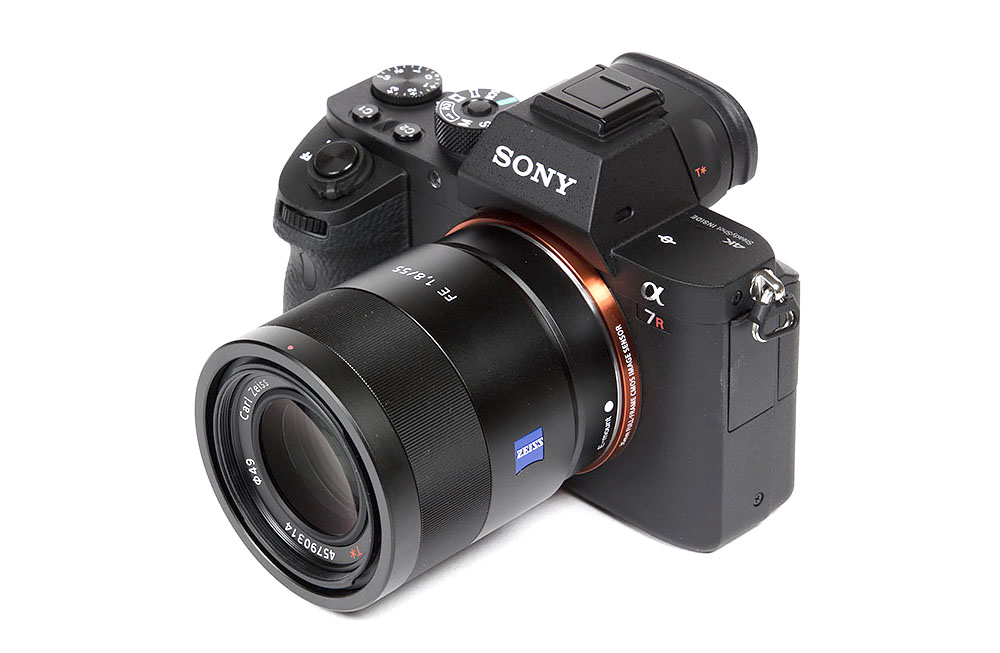
Welcome to our first review based on the Sony A7R II (42 megapixels). Some of you may be surprised why we just don’t continue on the original Sony A7R (36 megapixels). However, as good as it was on paper, the original A7R was a deeply flawed camera. The rather extreme shutter vibrations made it very difficult to achieve reliable results. We’ll re-test all previously covered lenses on the A7R II but for a fresh start, let’s first have a look at the Zeiss Sonnar T* FE 55mm f/1.8 ZA.
Just to mention the origin of the “Sonnar” portion in the lens’ name again – Sonnar is derived from the German word “Sonne” (sun) and is used for fast Zeiss lenses. Sonnars are using a reduced amount of elements for better contrast and flare compared to “Planars” although the latter are generally sharper (less aberrations). Now a maximum aperture of f/1.8 is not exceedingly fast for a 50/55mm lens but in the grand scheme of things it certainly is. Conventional 50mm f/1.8 lenses aren’t overly expensive – in the DSLR world the pricing hovers around the 200 US$ mark – but mirrorless prime lenses are always more expensive and the Zeiss brand will has its share in a price tag of around 1000 US$/900 EUR. This will certainly cause headaches among some potential buyers. Whether the lens is worth this amount of money … well … we’ll see.
The Sonnar is very small, light-weight lens. However, the low weight doesn’t come at the cost of build quality which is pretty much exceptional. The outer barrel, the mount as well as the focus ring are made of metal whereas the inner frame for the optics is made of plastics. Everything is tightly assembled with no wobbling whatsoever. The focus ring operates smoothly and it’s even slightly dampened. The lens also features a weather sealing. A deep petal-shaped lens hood is also part of the package.
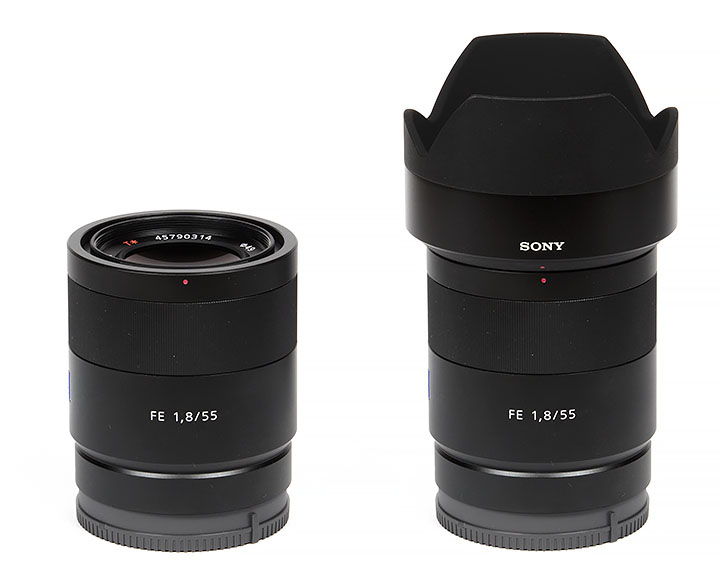
The AF speed of the Zeiss lens is good although not impressive. AF operations are essentially noiseless. Typical for E-mount lenses, focusing works “by-wire”. The implementation is really good and allows very fine grained focusing.
| Specifications | |
|---|---|
| Optical construction | 7 elements in 5 groups inc. 3x aspherical elements |
| Number of aperture blades | 9 (circular) |
| min. focus distance | 0.35m (1:7.1) |
| Dimensions | 64x71mm |
| Weight | 281g |
| Filter size | 49mm |
| Hood | supplied, petal-style, bayonet mount |
| Other features | Weather Sealing |
Distortion
Standard lenses are usually pretty much free of image distortions and this also applies to the Zeiss lens. A pincushion distortion of just 0.3% is absolutely negligible.
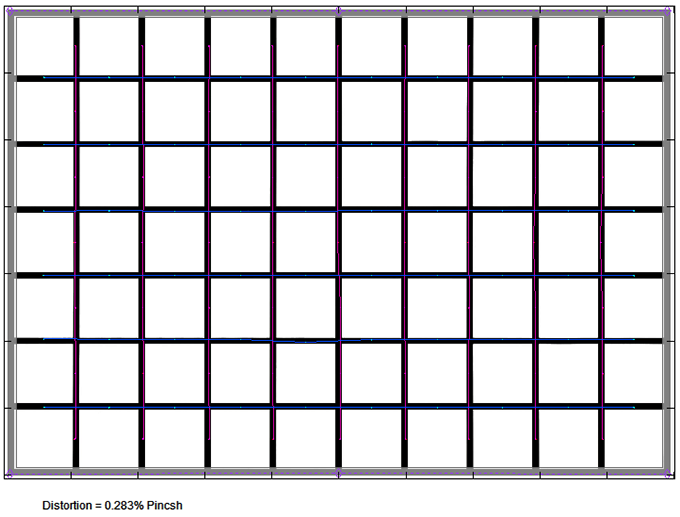
Vignetting
At fully open aperture, the light falloff reaches a very hefty 2.6EV (f-stops) – this is immediately noticeable. To be fair, this is also the typical amount of vignetting for such lenses on full format cameras. Stopping down to f/2.8 results in a substantial improvement (1.2EV) but it’s best to stop down to f/5.6 from where on the vignetting isn’t objectionable anymore.
Please note that vignetting can be auto-corrected both in the camera or via various RAW converters out there. Due to the signal amplification this comes at cost of increased sensor noise noisy in the corners though.
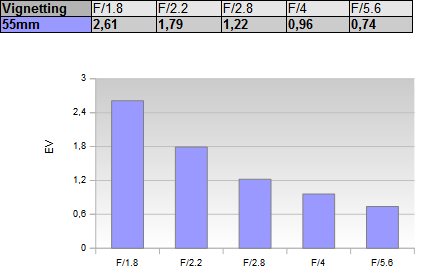
MTF (resolution)
Mirrorless cameras (sensors) require excellent optics to make the most of their potential. The Zeiss Sonnar T* 55mm f/1.8 ZA lens is generally capable of delivering impressive results although it’s not perfect. The center zone is very good at f/1.8 but the outer image field just makes it across the “good” mark here. Stopping down to f/2.2 boosts the dead center into outstanding quality. The “near-center” as well as the outer image zones are improving more gradually the more you stop down. The best results are achieved around the f/4-5.6 marks. Even the extreme corners are very good at these apertures. Diffraction degrades the quality from f/8 onward but the results are still sharp at f/11.
The centering quality of the tested sample was good.
Please note that the MTF results are not directly comparable across the different systems!
Below is a simplified summary of the formal findings. The chart shows line widths per picture height (LW/PH) which can be taken as a measure of sharpness. If you want to know more about the MTF50 figures you may check out the corresponding Imatest Explanations.

Chromatic Aberrations (CAs)
The Zeiss lens produces a very low amount of lateral CA (color shadows at harsh contrast transitions) starting with an average CA pixel width of 0.8px at f/1.8 and decreasing down to half that amount at medium aperture settings. This is impressive on a 42mp sensor.
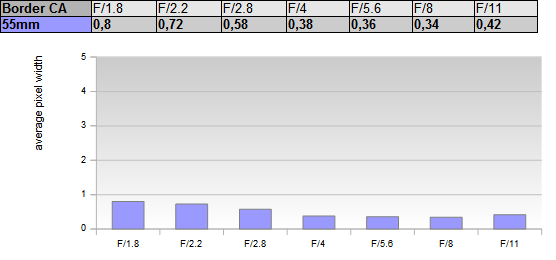
Bokeh
The bokeh describes the rendition of out-of-focus blur in the focus transition zone – thus the area just beyond the depth-of-field. This is sometimes misunderstood – it is NOT about the blur of the far background. If the focus spread between your main object and the surroundings are big enough, pretty much any lens can produce a smooth blur.
The Zeiss Sonnar T* FE 55mm f/1.8 ZA is somewhat complex regarding its bokeh characteristic.
Out-of-focus highlights have a circular shape at f/1.8 to f/2.8 but the inner zone is very nervous. It is likely that the 3 aspherical elements have a fair share in this issue. As usual the highlight discs deteriorate to “cat’s eyes” towards the corners but this is a rather normal behavior in the full format scope. Stopping down helps to tame this aspect to some degree.

On the positive side, the rendition in the critical focus transition zone is very smooth and buttery in the image background. The rendition in the less critical foreground is somewhat more rough though.

Bokeh Fringing / Longitudinal Chromatic Aberrations (LoCA)
So-called bokeh fringing is an effect that occurs around the focus point (on the Z-axis). It’s visible as halos of different colors in out-of-focus areas – magenta (red + blue) in front of the focus point and green beyond.
The Zeiss lens exhibits a significant amount of bokeh fringing at f/1.8 and it’s still obvious at f/2.2 and f/2.8. An improvement can be seen at f/4 although traces remain visible even at f/5.6.

Sample Images
The Zeiss Sonnar T* FE 55mm f/1.8 ZA is certainly capable of delivering stunning results … if you are aware of a few limitations. The image center is sharp at f/1.8 but the outer image region isn't quite as impressive here. Now that being said you should ask yourself in how far sharp corners are critical for your applications at this setting. Stopping down improves the overall quality, of course. For a tack sharp center it is already sufficient to stop down to f/2.2. If you require critical sharpness across the image field, you should stop down to f/4.
The lens produces some heavy vignetting at maximum aperture. Some may like this effect as a creative element but those who don't may prefer to correct this either via camera setting or in your favorite RAW converter. Otherwise you should stop down by about 2 f-stops. Lateral CAs are no issue at all nor are image distortions. The Zeiss lens is certainly a fast lens so the quality of the bokeh is a primary characteristic for shallow depth-of-field photography. The results are a bit mixed here. The critical blur in the image background is nicely rendered whereas the foreground isn't as pleasing (still good). Out-of-focus highlights are rather rough. A fair share of bokeh fringing is also present.
On the mechanical side we have nothing but praises. The Zeiss lens is small but it feels really solid. Combined with inner focusing, smooth controls and weather sealing this is about as close to perfection as it gets these days. The AF is quite fast although it won't win against similar DSLR lenses here for sure. Manual focusing is very precise and smooth. Some may disagree but we actually like the focus-by-wire system.
So finally there's the big question whether the high price tag is really worth the sacrifice. Well, at the time of this review you don't really have another choice if you want a standard prime lens with AF which may already answer the question for some. However, honestly speaking we think that Sony went a bit insane here. The lens is undoubtedly good but one thousand dollars for a 55mm f/1.8 lens … ?
-
Optical Quality
-
Build Quality
-
Price / Performance

